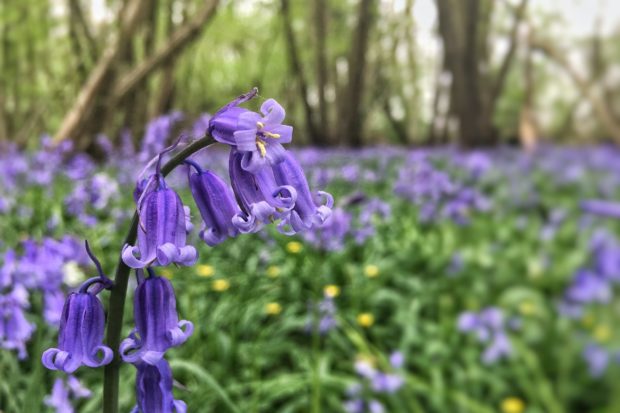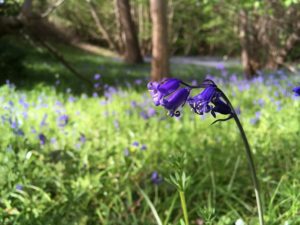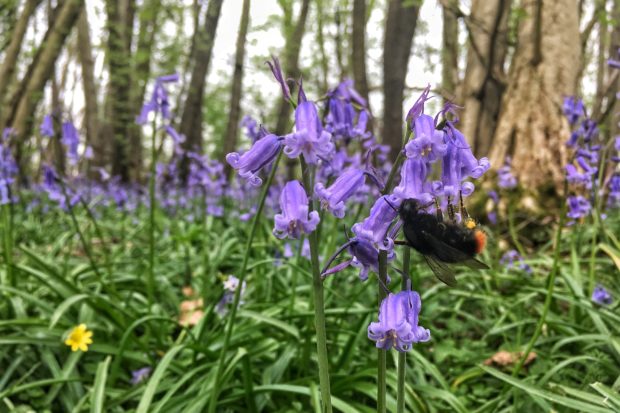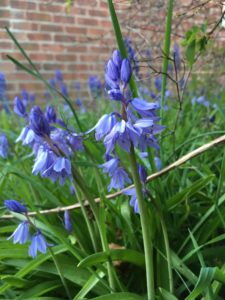Bluebells at a greenspace near you

Bluebells are a seasonal treat to enjoy, bringing happiness to many. A very delicate flower that doesn’t recover from trampling, they’re almost always found in native broadleaved woodlands.
There are several areas around the Thames Basin Heaths that are good spots to see bluebells from around the end of April.
Ambarrow Court & Hill – Part of a former Victorian country estate, close to Sandhurst, its ancient and mixed woodlands are now managed with bluebells and other wildlife in mind. As a result, these much loved and delicate flowers are flourishing.
Chantry Wood – A large mixed woodland a short distance from Guildford. The spectacular bluebell display is large enough for their soft scent to fill the air.
Rowhill Nature Reserve – Not far from Aldershot, this beautiful mix of habitats makes a great walk and the bluebells are putting on a show in the broadleaved woodland. Their continued existence is probably aided by coppicing, a traditional activity to harvest wood that results in increased light levels to the woodland floor.
Southwood Woodland – A woodland nature reserve near Farnborough. Try visiting at the end of April/early May when bluebells and other wildflowers are normally at their best.
More places to try…
- Chertsey Common at Longcross
- Naishes Wood at Crookham Park, not far from Church Crookham
- St. Ann’s Hill near Chertsey
- Piglittle Field close to Binfield
For directions and more information, please visit our ‘Greenspace on your doorstep’ guide. Remember that bluebells are a protected wildflower so please refrain from picking or digging up the plants.
Enjoy the magic of this seasonal colour and please do send in your bluebell pictures and share any other great places to see them.
Bluebell identification and ecology
 If in search of British bluebells, the best place to start is the woods and in particular ancient woodlands, from around the end of April. You’re unlikely to find them in plantation woodlands of conifers, as there’s not enough light reaching the ground. Bluebells are primarily found in ancient and undisturbed woodlands because they have very poor dispersal abilities, meaning they take a long time to spread across a woodland floor. It takes four to five years to go from seed to flower, and studies have shown a spread of only 10 meters in a century!
If in search of British bluebells, the best place to start is the woods and in particular ancient woodlands, from around the end of April. You’re unlikely to find them in plantation woodlands of conifers, as there’s not enough light reaching the ground. Bluebells are primarily found in ancient and undisturbed woodlands because they have very poor dispersal abilities, meaning they take a long time to spread across a woodland floor. It takes four to five years to go from seed to flower, and studies have shown a spread of only 10 meters in a century!
The following features separate our native British bluebell from the Spanish bluebell. The Spanish flower is a garden escape that threatens the native variety through hybridisation. Hybrid bluebells show a combination of features:
Native British bluebell
- Creamy white pollen
- Flowers on one side of the stem only, with a rich dark blue colour and lightly scented
- Flower maintains tight bell shape, opening out at the very end only
- Stem curves at the top (not dead straight)
- Leaves and stem delicate
- Pale powder blue pollen, similar colour to the flower
- Flowers on all sides of the stem, pale sky blue with no scent
- Flowers much more open
- Stems are dead straight/upright
- Leaves and stem broader and fleshier
Remember that native bluebells are a protected wildflower so please refrain from picking or digging up the plants. They are incredibly delicate and will wither and die if trampled so please stick to the paths when in bluebell woods so that everyone can enjoy them. If you’d like bluebells for your garden then check your garden centre for bulbs that have been cultivated, not taken from the wild.
Warden Rob


